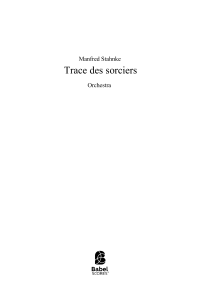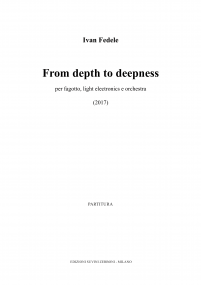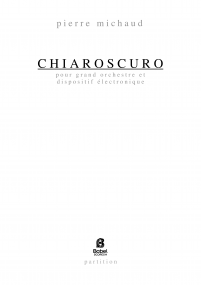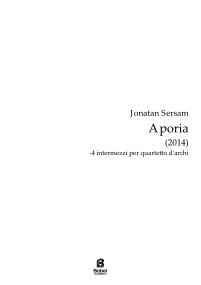Recherche avancée
Mens Sana in Corpore Sano
(actors/scenario)
ISMN : 979-0-2325-5312-2
- Identifiez-vous pour créer une liste
- Mens Sana in Corpore Sano (for two flutes, two oboes, two english horns, two clarinets and two bassoons) from the Latin expression meaning a ‘sound mind in a healthy body’.
In Mens Sana in Corpore Sano, there are two main scales with nine notes each being the intervals a major 3rd, perfect 5th, major 2nd, perfect 4th, minor 2nd, minor 3rd, perfect 5th, minor 6th. The origin of the two scales came from the division in two parts of the Latin expression used as the title, i.e. Mens Sana + Corpore Sano.
The first note of both scales is B – Si (Mens Sana in Corpore Sano), corresponding to a mysterious hidden message and word - ‘sanity’. The goal to be achieved is the equilibrium between Mens and Corpus thus the symbology of the large pair of scales (two scales), with an actor (jester) in each scale, used as a performance element in the piece.
In Mens Sana in Corpore Sano there are the following parts:
.Introduction
.Section 1, 2, 3, 4 and 5
.End
The piece starts with the percussion played by the two actors seated on a large pair of scales placed behind the ensemble. The actor seated on the left scale, i.e. the audience’s left side, goes up and down playing the clapper drum’s tremolo (bars 1 to 10) and the actor seated on the right side, i.e. the audience’s right side, goes up and down playing the slapstick’s attack when he reaches the ground or the top (bars 1 to 10).
The woodwinds play a descendent/ascendant movement symbolizing the up and down motion of the pair of scales. To intensify the idea of ‘disequilibrium’, four other instruments from the flute’s and clarinet’s families are used: piccolo, bass flute, piccolo clarinet D and bass clarinet.
Five sections follow this introduction, becoming shorter towards the end (less number of beats as shown on the previous table). The idea of “removing an object from the head”, from Bosch’s painting The Stone Operation (1475-80) contributed to this conception.
At the end, the ‘equilibrium’ desired between mind and body is achieved. This achievement is symbolised by the short movement of the left and right scales. From bars 85 to 91 they move less and less and afterwards, from bars 92 to 95, the pair of scales stays balanced. Also the gesture played by the woodwinds instead of being a descendant/ascendant movement as before is a repetition of notes stabilizing the movement.
In Mens Sana in Corpore Sano the woodwind ensemble is divided into two Group 1 (flute 1, oboe 1, english horn. 1, clarinet in Bb 1, bassoon 1) and Group 2 (flute 2, piccolo, bass flute, oboe 2, english horn. 2, clarinet in Bb 2, piccolo cl in D, bass clarinet in Bb, bassoon 2) symbolizing the duality mind and body implicit in the title, i.e. Mens + Corpus.
The stage plan is the following:

In the piece, the actors’ costume and their mimetic action as fools were influenced by the character of the fool in Bosch’s painting The Ship of Fools (1500) and in Dürer’s woodcuts included in Sebastian Brant’s book The Ship of Fools (1494).
In Bosch’s painting the “guzzling fool” is “in the rigging”. “For centuries the court jester or fool had been permitted to satirize the morals and manners of society, and it is in this capacity that he appears in prints and paintings from the mid fifteenth century on, distinguished by his cap adorned with ass’s ears and carrying a baton topped by a small replica of his own vacantly grinning features.”
“In Sebastian Brant’s book, Dürer contributed with a number of comic woodcuts considered a ‘major contributor to its popularity’.
Originally written by the distinguished humanist Sebastian Brant (1458-1521) in 1494 and published in Basel, the Narrenschiff was one of the most successful published works of its age. Also known as the Stultifera Navis or Ship of Fools, the work was first published in German, but there was a gradual demand for it to be translated into all the leading European languages of the time. Jacob Locher adapted it into Latin in 1497. It appears that subsequent translations into French and English were based upon this edition. The first Flemish translation was published in 1500 by Guyor Marchand, a Flemish printer living in Paris. Although Marchand’s edition draws on the earlier German editions, for the most part it is based on the Locher translation. Alexander Barclay was responsible for the original English translation, or adaptation, of the Ship of Fools, which was first published in 1509. Such a demand for widespread accessibility, especially when printing was still so new and expensive, is evidence of the work’s great popularity.”
“While it was first thought that Brant himself was the fundamental contributor to the design of the cuts, the bulk of the work is now most commonly attributed to Albrecht Dürer of Nuremberg. Dürer is considered a very fine and influential woodcut designer, only faulted for his tendency to exaggerate and over-emphasise.”
“Dürer woodcuts are claimed to be the first examples of intentionally comic illustration in the printed book. The fools themselves are depicted with ass-eared head-dresses, laden with bells, and occasionally carrying a "fool-stick" which has a replica fool’s head on its end. They are often depicted talking to animals.
Settings\Administrator\My Documents\Paginas da NET\painting\Ship of Fools.htm, Julie Gardham
“These cuts are delicate and yet sure of touch. The artist reveals deftness, a pronounced talent for the figurative, great virtuosity, yet also refreshing simplicity and naturalness.”
Pages - 42




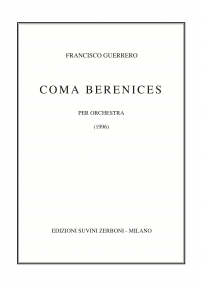
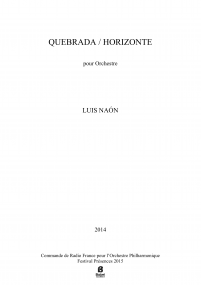
_Petrassi 1_285x285.png)
